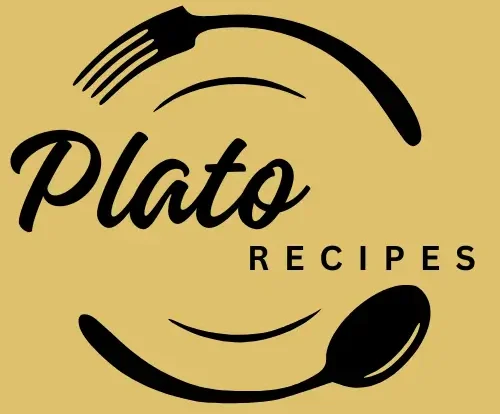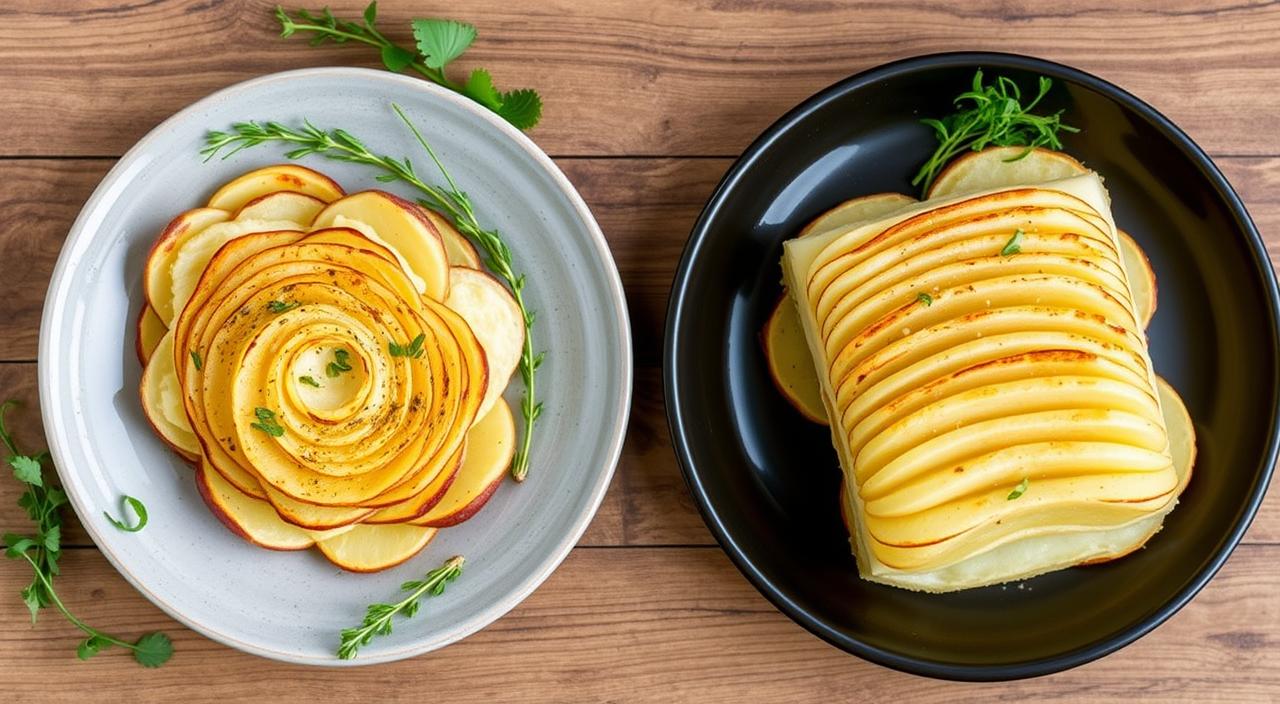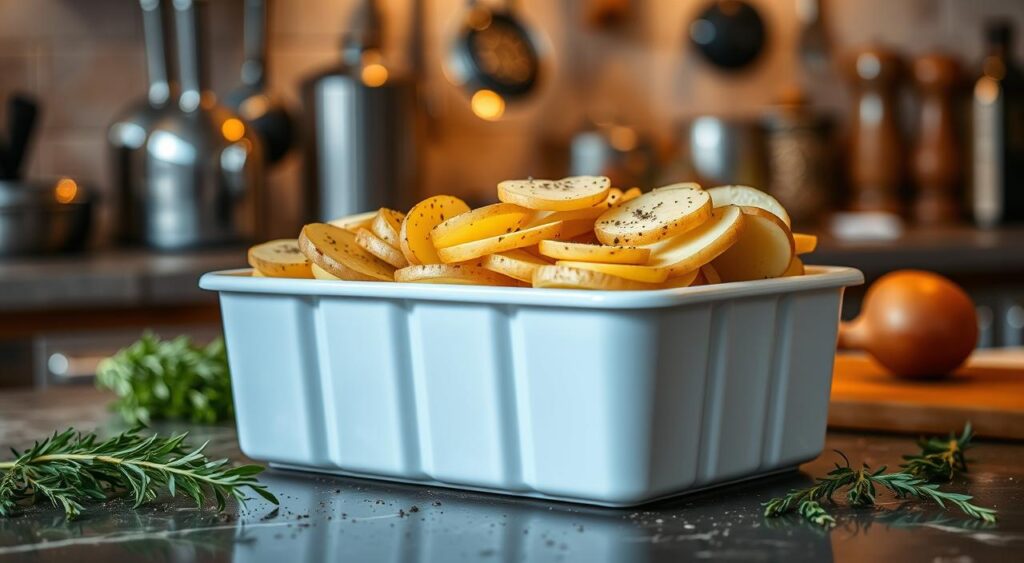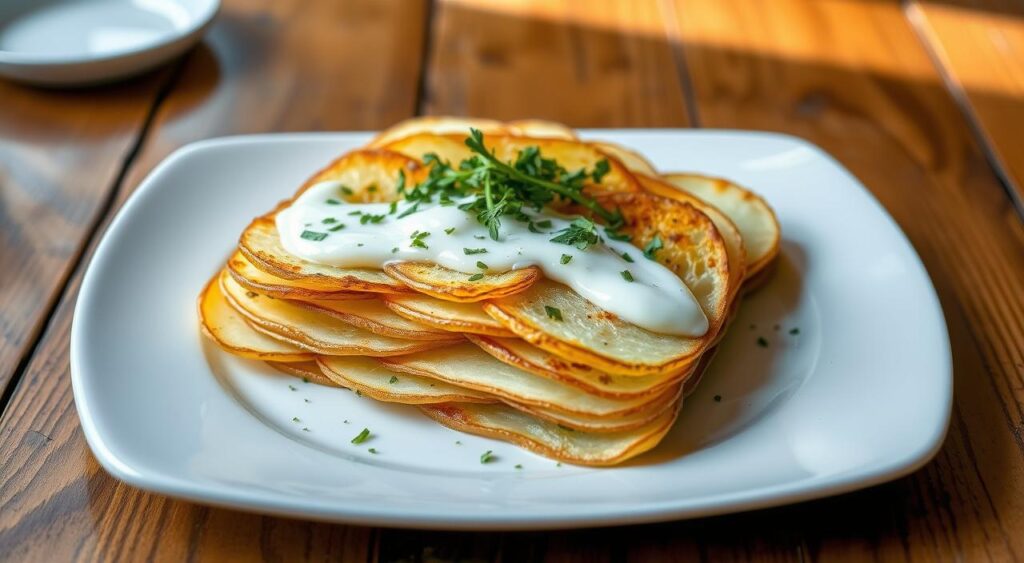Growing up in a kitchen that loved French food, I was always drawn to potato dishes. The potato pave and dauphinoise were more than just sides. They were stories of tradition and skill, each layer telling its own tale.
At first glance, these two French potato dishes seem the same. They both have thinly sliced potatoes in rich cream, baked until golden. But, the potato pave is a more refined version of the classic dauphinoise.
The potato pave is special because of its precise layering and pressing. It’s not like its rustic cousin. Imagine potatoes sliced super thin, pressed into a perfect block, then baked, cooled, and weighted. This creates a dense, elegant potato cake.
Key Takeaways
- Potato pave is a more structured version of potato dauphinoise
- Both dishes use cream and thinly sliced potatoes
- Potato pave requires precise layering and compression
- The dishes differ in preparation and final presentation
- Each represents a unique approach to French potato cuisine
Understanding Traditional French Potato Dishes
French cuisine is known for its rich potato dishes. These dishes turn simple ingredients into culinary masterpieces. The potato pave recipe is a top example of French cooking skill.
French potato dishes have a long history. They show not just cooking methods but also a whole culinary philosophy. This philosophy has been passed down through generations.
Origins of French Potato Preparations
The word pavé means “cobblestone” in cooking. It perfectly describes the rectangular shape of this famous potato dish. These dishes come from local cooking traditions, where ingredients and techniques created unique dishes.
- Potatoes were introduced to France in the 16th century
- Regional cooking styles made unique dishes
- Potato dishes became beloved comfort foods
Cultural Significance in French Cuisine
Potato dishes mean more than just food in French culture. They show creativity, resourcefulness, and the power to make simple ingredients into something special.
“In French cooking, even the simplest potato can become a work of art” – Classic French Culinary Saying
Evolution of Cooking Techniques
The potato pave recipe has changed from simple home cooking to fancy restaurant dishes. Chefs now use tools like mandoline slicers and careful layering. This shows their skill and respect for old ways.
- Traditional hand-slicing techniques
- Introduction of precise kitchen tools
- Modern restaurant interpretations
Learning about these potato dishes helps us understand French culinary traditions better.
Essential Ingredients for Both Dishes
To make a perfect potato pave dish, you need the right ingredients. These ingredients turn simple potatoes into a work of art. Knowing the right ingredients can take your cooking to the next level.
- Yukon Gold or Russet potatoes (5 pounds)
- Unsalted butter (6 tablespoons)
- Fresh Parmesan cheese (⅔ cup, finely grated)
- Heavy cream (1 cup)
- Canola oil (¼ to ⅓ cup)
- Salt and freshly ground black pepper
High-quality ingredients are key to a great potato pave. Yukon Gold potatoes are especially good because they’re creamy and hold their shape well.
Choosing the right potatoes is like selecting the perfect canvas for a masterpiece.
When making your potato pave, watch the potato thickness. Aim for slices about 1/16 of an inch thick. This ensures even cooking and a soft texture. A sharp mandoline slicer is best for these thin cuts.
Think about the nutrition too. Each serving of potato pave has about 296 calories. It has 18 grams of fat and 6 grams of protein. It’s a rich, satisfying side dish that goes well with many main courses.
The Art of Potato Pave Preparation
Making the perfect potato pave needs precision and skill. It turns simple ingredients into a beautiful dish that will wow food lovers.
Mastering the Mandoline Slicing Technique
Start with expert slicing for your potato pave. Use a sharp mandoline to get slices about 1/16 inch thick. It’s important to wear cut-resistant gloves for safety.
- Select high-starch russet potatoes
- Aim for consistent slice thickness
- Keep slices paper-thin and even
Strategic Layering and Seasoning
The secret to potato pave is in its layering. Place potato slices in overlapping rows. Between layers, brush with melted butter and sprinkle seasonings.
“Precision is the soul of potato pave preparation” – Classic French Culinary Wisdom
Compression and Chilling Techniques
After layering, press your potato pave to make it dense. Use weights to press the layers together. Then, chill it for at least 12 hours to set.
- Compress layers thoroughly
- Chill for minimum 12 hours
- Maintain consistent temperature
With the right technique, your potato pave will turn into a stunning dish. It will show off the beauty of French potato cooking.
Classic Dauphinoise Cooking Method
To make a real potato pave recipe, you need to learn the traditional dauphinoise cooking way. This French method turns simple ingredients into a rich potato dish that will wow your dinner guests.
Starting a perfect dauphinoise means picking the right ingredients. Choose potatoes like Russet or King Edward for their creamy texture. For your potato pave, slice potatoes to 1/8-inch thick using a mandoline for even cooking.
- Select 2.5 pounds of starchy potatoes
- Prepare 2 cups heavy cream and 1 cup whole milk
- Use fresh garlic for enhanced flavor
- Preheat oven to 360°F (180°C)
The secret to a great dauphinoise is in how you layer and simmer it. Start by heating cream, milk, and garlic gently. Add sliced potatoes, seasoning with salt and pepper. Simmer for about 20 minutes until the potatoes are tender.
“The magic of dauphinoise is in its patient preparation and layered complexity.” – French Culinary Tradition
Put half the potatoes in a baking dish, sprinkle with cheese. Then, layer the rest, making a rich, layered potato dish. Bake covered for an hour, then without cover for 30 minutes to get a golden, crispy top.
Your potato pave recipe will give you a creamy, indulgent side dish. It serves 6-8 people and shows the beauty of French cuisine.
Temperature and Timing: Critical Differences
Mastering the potato pave dish needs precision in temperature and timing. Each step affects the final texture and flavor of this sophisticated potato creation.
Precise Baking Temperature Guidelines
When making your potato pave dish, follow these key temperature tips:
- Preheat oven to 325°F (160°C)
- Bake for 90 minutes
- Allow 15 minutes resting time after baking
Resting and Setting Techniques
The potato pave needs careful chilling for its signature dense texture. Refrigerate the dish for 12-48 hours to get the right compression and setting.
“Patience is key in creating the perfect potato pave texture” – Professional Chef Recommendation
Storage and Preservation
Proper storage keeps your potato pave fresh and quality:
- Refrigerate immediately after cooling
- Store in an airtight container
- Consume within 3-4 days
To reheat, use a gentle oven temperature of 350°F for 10-15 minutes. This keeps the potato pave’s crisp exterior and creamy interior.
Texture and Presentation Variations
Potato pave is all about texture and presentation. It has a unique layered structure and a crispy outside. This dish offers a special dining experience with both great looks and taste.
Preparing potato pave involves several key steps:
- Precise mandoline slicing to create uniform 1/8-inch potato layers
- Compression of layers to create a dense, structured terrine
- Searing for a golden, crispy exterior
- Strategic plating to showcase the dish’s architectural design
With some effort, your potato pave can look like a dish from a fancy restaurant. Chill it overnight, then cut it into perfect squares. Pro tip: Use a hot skillet with a touch of butter to achieve that coveted crispy golden finish.
The beauty of potato pave lies in its ability to blend rustic comfort with refined culinary technique.
Experts say to use Yukon Gold potatoes for their creamy texture and layering. Each serving has about 300 calories. You can also add herbs like thyme or garlic for more flavor.
Whether it’s for a holiday meal or a fancy dinner, potato pave is a show-stopper. It will wow even the pickiest eaters.
Common Cooking Challenges and Solutions
Making the perfect potato pave recipe can be tough, even for experts. Knowing the common problems helps you make a dish that wows everyone.
To master a potato pave recipe, you need to pay close attention and use the right techniques. Let’s look at some common issues you might face while cooking.
Preventing Cream Separation
Cream separation can mess up your potato dish’s smooth texture. Here’s how to avoid it:
- Choose full-fat dairy products
- Keep the oven temperature steady, between low and medium
- Don’t let the temperature change too fast
“The key to a perfect potato pave is patience and careful temperature control.” – Professional Chef
Achieving Perfect Potato Layers
Getting uniform potato layers takes practice and the right method:
- Use a sharp mandoline for even slices
- Pat dry the potato slices before layering
- Press the layers gently when stacking
Troubleshooting Tips
If your potato pave doesn’t turn out right, try these quick fixes:
- Make sure the potatoes are sliced evenly
- Season each layer well
- Let it rest properly after cooking
With practice, you’ll get better at making a potato pave that looks like it came from a restaurant.
Serving Suggestions and Pairings
Your potato pave dish is perfect for fancy meals. It turns simple potatoes into a gourmet delight. This classic French dish makes any meal special.
- Roasted meats like herb-crusted chicken or tender beef tenderloin
- Pan-seared fish with delicate white wine sauce
- Vegetarian options such as grilled portobello mushrooms
“A perfectly prepared potato pave is not just a side dish, it’s a culinary statement.” – Culinary Experts
Wine lovers will enjoy pairing it with Sauvignon Blanc or Pinot Noir. These wines bring out the potato pave’s creamy texture.
For a fancy look, try these toppings:
- Flaky sea salt
- Fresh chives
- Optional caviar or truffle oil
- Grated Parmesan cheese
Whether it’s a family dinner or a fancy party, your potato pave will wow everyone. Its layers and flavors are truly impressive.
Conclusion: Making the Right Choice for Your Menu
Choosing between potato pave and dauphinoise depends on your cooking goals and skill. Potato pave is known for its precise layering, coming from the south of France. It’s all about the dining experience you aim to create.
Remember, potato pave needs careful preparation. You can add truffle oil or smoked paprika for a unique taste. Try different potatoes like sweet or purple ones for more nutrition and color.
How you cook matters a lot. Baking can cut calories by half, fitting today’s health trends. Chefs know that how food looks is as important as how it tastes. Mastering potato pave makes your dish both delicious and beautiful.
Whether you pick potato pave or dauphinoise, use the best, local ingredients. This boosts flavor and cuts down on waste by 30%. Let French cooking inspire you and add your own twist to these classic dishes.
FAQ
What exactly is potato pave?
Potato pave is a fancy French dish made from thinly sliced potatoes. These slices are pressed into a dense, rectangular block. It’s seasoned, then sliced and pan-seared for a crispy outside and soft inside.
How is potato pave different from potato dauphinoise?
Potato pave is a compressed dish that can be cut into neat squares. Dauphinoise, on the other hand, is creamier and served straight from the dish. Pave is firmer and can be seared for extra crispiness.
What type of potatoes work best for potato pave?
Starchy potatoes like Russet or Yukon Gold are best for potato pave. They keep their shape well and become dense when sliced and pressed.
Do I need special equipment to make potato pave?
Yes, a mandoline slicer is key for thin slices. You’ll also need a rectangular dish, parchment paper, and something heavy to press it down.
Can potato pave be prepared in advance?
Yes, you can make potato pave ahead of time. Prepare it, chill it, then slice and sear it just before serving. It’s great for planning meals.
How long does potato pave take to prepare?
It takes about 2-3 hours to prepare, including baking, chilling, and searing. But only 45 minutes of actual work.
Is potato pave considered a difficult recipe?
It’s not too hard, but it needs precision in slicing and layering. It’s best for cooks who enjoy detailed work.
What are good serving suggestions for potato pave?
It goes well with roasted meats, as a fancy side dish, or as a standalone appetizer. It’s especially good with beef, lamb, and poultry.
Can I make potato pave vegetarian or gluten-free?
Yes, it’s naturally gluten-free. Use plant-based butter or olive oil to make it vegetarian.
How do I achieve a crispy exterior when making potato pave?
Chill and slice it, then sear it in a hot skillet with butter or oil. This makes the outside crispy while keeping the inside creamy.



